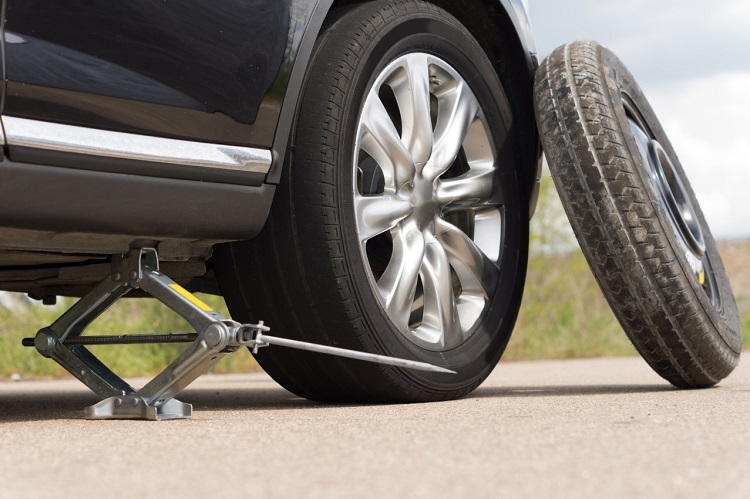Before you start
Make sure you find a safe place to park. It’s better to drive further and risk damaging the wheel rim than stop somewhere dangerous – such as on a narrow road.
Leave your hazard lights on when you park. Put on your reflective jacket if you have one, and position your warning triangle to alert oncoming drivers.
It’s advisable to read your car’s manual for advice first.
What equipment do you need?
Apart from the spare wheel, you will need the following:
Wrench – for removing the wheel nuts
Jack – for lifting the car off the ground
Wheel chock – to stop the car from rolling when jacked up (bricks can be used instead)
Wheel nut key – if locking nuts are fitted
Car handbook – for reference (e.g. on jacking points)
It may also be useful to carry:
Torch – for working at night (check batteries regularly)
Gloves – wheels will be dirty
Reflective jacket – to make you visible
Warning triangle – to alert other drivers to a hazard/obstruction
Short plank of wood – as a flat surface to steady the jack
Tyre pressure gauge – for checking the new tyre is fully inflated
- Prepare the car
Apply the handbrake and remove all passengers from the car.
Take the spare wheel and necessary tools out of the boot.
- Position the wheel chocks
Chocks prevent the car from rolling while jacked up.
Position a chock on the opposite wheel to the one with a puncture.
For example, if your left-front tyre has a puncture, put a chock behind the right-rear wheel.
If your left-rear tyre is flat, you need a chock in front of the right-front.
Use chocks for both front/rear wheels (as appropriate) if you have them.
Bricks or large rocks can do the same job if you don’t have a dedicated chock.
- Loosen the wheel nuts
It’s easier – and safer – to do this while the car is on the ground.
You may need to lever off a plastic wheel trim first.
Turn the wheel wrench anti-clockwise and loosen the nuts to the point where they can be turned by hand (be warned – they may be tough to loosen).
However, don’t remove them completely yet.
- Jack the car up
All cars have dedicated jacking points – consult your handbook to see where these are.
Aim to position the jack at the side of the car, close to the punctured wheel.
Placing a small plank of wood under the jack will help keep it stable.
Raise the car slowly until the flat tyre is 10-15cm off the ground.
- Remove the flat tyre
Fully loosen and remove the wheel nuts, then gently pull the tyre towards you until it comes free. Place it flat on the ground.
- Mount the spare wheel
Slide the spare wheel onto the protruding hub bolts, or in line with the wheel nut slots (warning: it’s heavy to lift it off the ground to do this).
Replace the wheel nuts and tighten them by hand.
- Lower the car and tighten the bolts
Use the jack to drop the car down slightly, so that the spare tyre is in contact with the ground.
Now use the wrench to fully tighten the wheel nuts.
- Fully lower the car
Bring the car fully down to earth and remove the jack.
Consider giving the wheel nuts a final check for tightness.
Stow the jack and the other tyre in the boot, along with the rest of your equipment.
Note: if your car has a space saver, the old wheel will take up more space in the boot.
- Check the spare tyre pressure
If you have one, use a tyre pressure gauge to check the spare wheel is fully inflated.
Alternatively, drive carefully to a petrol station and use the gauge there.
Pump up the tyre to the recommended pressure – as detailed in the handbook – if necessary.
- Take your punctured tyre for repair
Visit a garage or tyre fitters at the first opportunity and give them your punctured wheel.
They will advise whether to repair or replace it.
Don’t drive on a space-saver spare wheel for longer than is strictly necessary – they are only intended for emergencies.
courtesy of https://www.rac.co.uk/drive/advice/car-maintenance/how-to-change-a-tyre/













